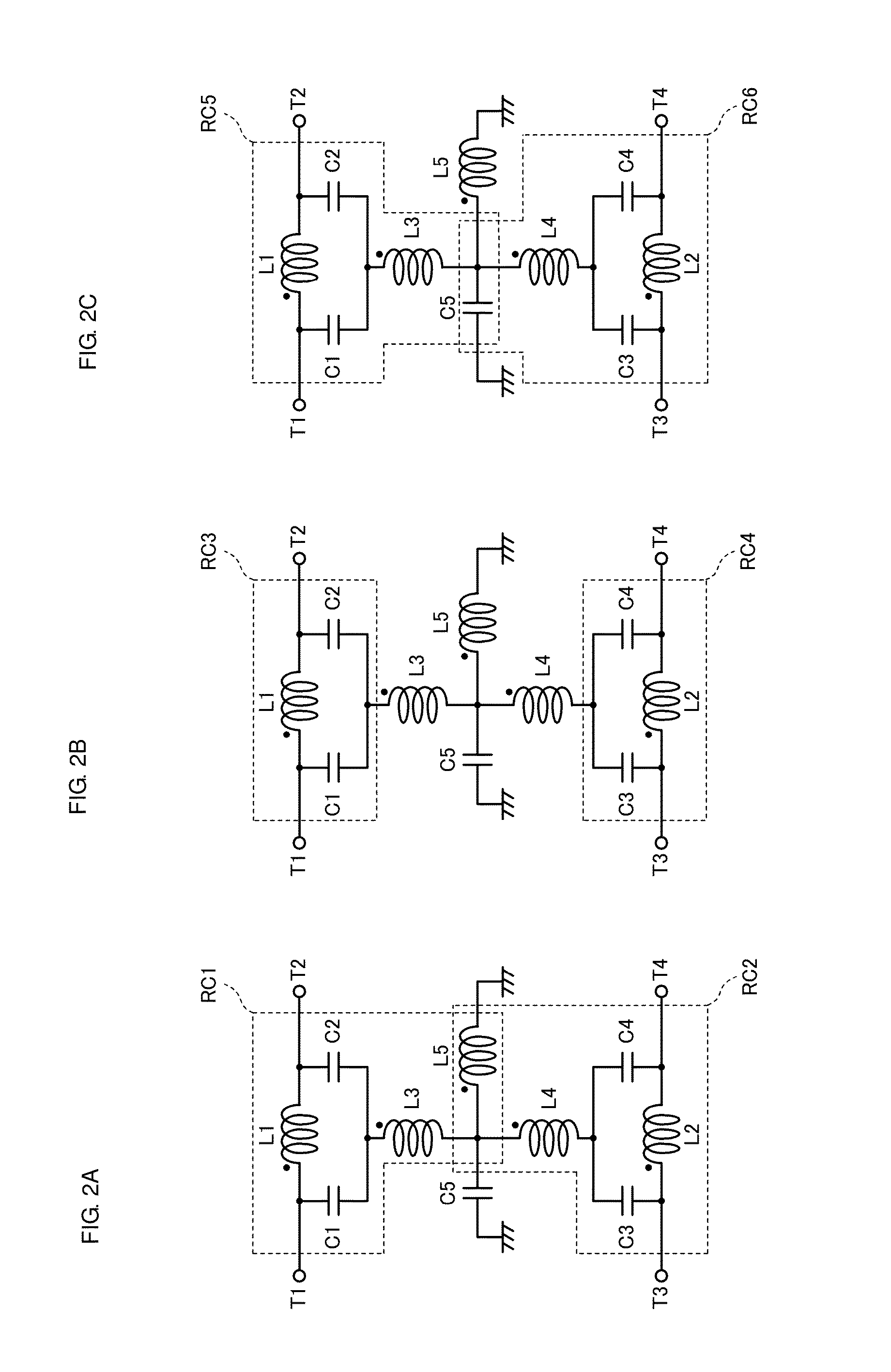Common mode filter and esd-protection-circuit-equipped common mode filter
a common-mode filter and protection circuit technology, applied in the direction of impedence networks, emergency protective arrangements for limiting excess voltage/current, inductance, etc., can solve the problem of low self-resonant frequency, large transmission loss of signals, and difficulty in using a common-mode choke coil in differential transmission lines that are used in high frequency, etc. problem, to achieve the effect of small coupling coefficient, small inductance and small coupling coefficien
- Summary
- Abstract
- Description
- Claims
- Application Information
AI Technical Summary
Benefits of technology
Problems solved by technology
Method used
Image
Examples
first preferred embodiment
[0040]A common mode filter according to a first preferred embodiment of the present invention will be described with reference to the drawings. FIG. 1 is a circuit diagram of a common mode filter 101 of the first preferred embodiment.
[0041]The common mode filter 101 illustrated in FIG. 1 is a balanced filter that is connected to a differential transmission line including a first signal line SL1 and a second signal line SL2. A first inductance element (hereafter, “first inductor”) L1 is inserted in series with the first signal line SL1 and a second inductance element (hereafter, “second inductor”) L2 is inserted in series with the second signal line SL2. The common mode filter 101 is provided with a ground that defines and functions as a reference for the first signal line SL1 and the second signal line SL2. In addition, the common mode filter 101 includes a third inductance element (hereafter, “third inductor”) L3, which includes a first end connected to a neutral point NP with resp...
second preferred embodiment
[0079]In a second preferred embodiment of the present invention, an example is illustrated in which characteristics are determined by the coupling of the third inductor L3 and the fourth inductor L4.
[0080]A circuit diagram of a common mode filter according to the second preferred embodiment is the same as that illustrated in FIG. 1 for the first preferred embodiment. In FIG. 1, when adopting a configuration in which the third inductor L3 and the fourth inductor L4 are coupled with each other, there is a configuration in which the inductors are differentially coupled for a common mode current and cumulatively coupled for a differential mode current (hereafter, “differential coupling”), and conversely, there is a configuration in which the inductors are cumulatively coupled for a common mode current and differentially coupled for a differential mode current (hereafter, “cumulative coupling”).
[0081]FIG. 10A illustrates frequency characteristics of the common mode filter when the differ...
third preferred embodiment
[0085]In a third preferred embodiment of the present invention, an example is illustrated in which a common mode filter is provided in a re-wiring layer of a semiconductor substrate.
[0086]FIG. 12 is a perspective view of an ESD-protection-circuit-equipped common mode filter according to the third preferred embodiment. A structure defined by a plurality of layers is illustrated and therefore the thickness in the stacking direction is drawn in an exaggerated manner. FIG. 13 is a plan view of each layer of the re-wiring layer. FIG. 14 is a circuit diagram of the ESD-protection-circuit-equipped common mode filter of this preferred embodiment.
[0087]FIG. 12 specifically illustrates a re-wiring layer RL provided on a surface of a semiconductor substrate SUB. In FIG. 12, a surface SS is the surface of the semiconductor substrate and is a surface below the re-wiring layer. Bidirectional Zener diodes ZD1 and ZD2 are defined by p-diffusion layers and re-diffusion layers in the semiconductor su...
PUM
 Login to View More
Login to View More Abstract
Description
Claims
Application Information
 Login to View More
Login to View More - R&D
- Intellectual Property
- Life Sciences
- Materials
- Tech Scout
- Unparalleled Data Quality
- Higher Quality Content
- 60% Fewer Hallucinations
Browse by: Latest US Patents, China's latest patents, Technical Efficacy Thesaurus, Application Domain, Technology Topic, Popular Technical Reports.
© 2025 PatSnap. All rights reserved.Legal|Privacy policy|Modern Slavery Act Transparency Statement|Sitemap|About US| Contact US: help@patsnap.com



